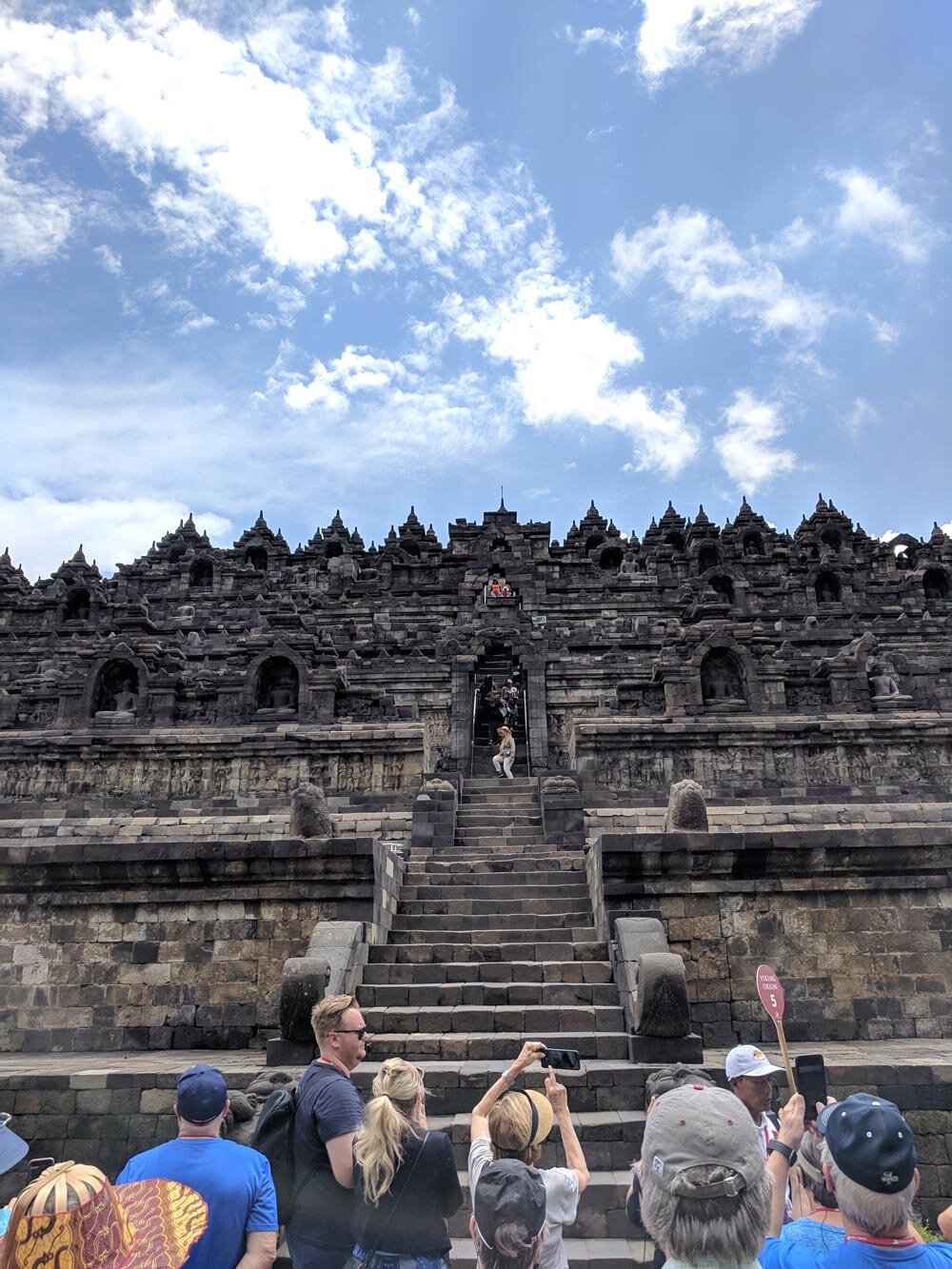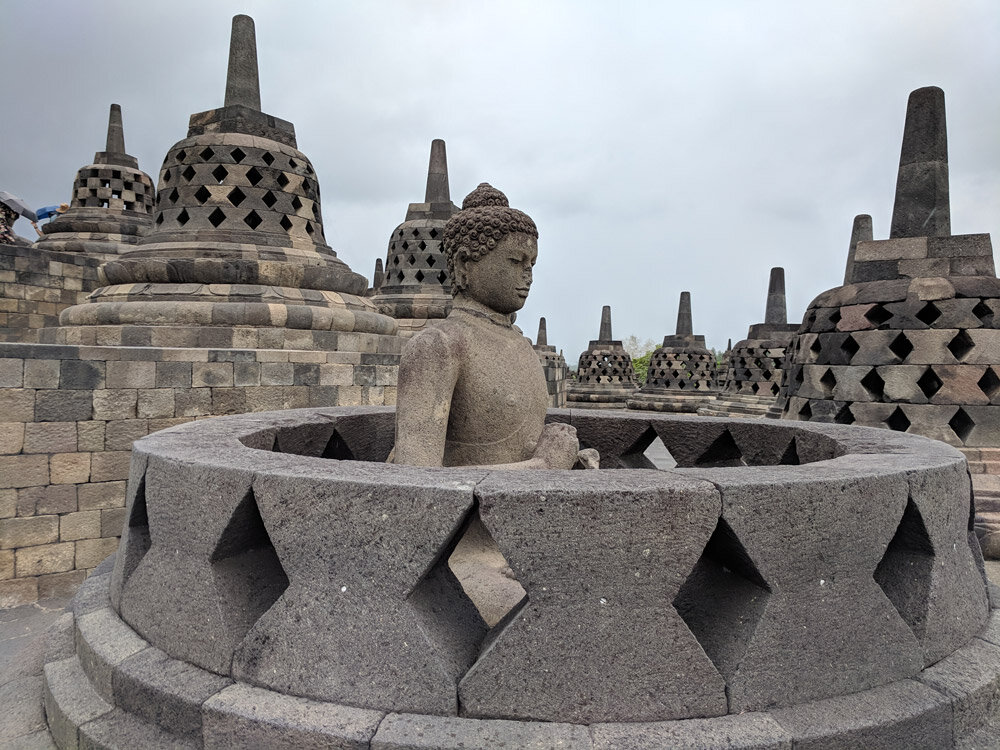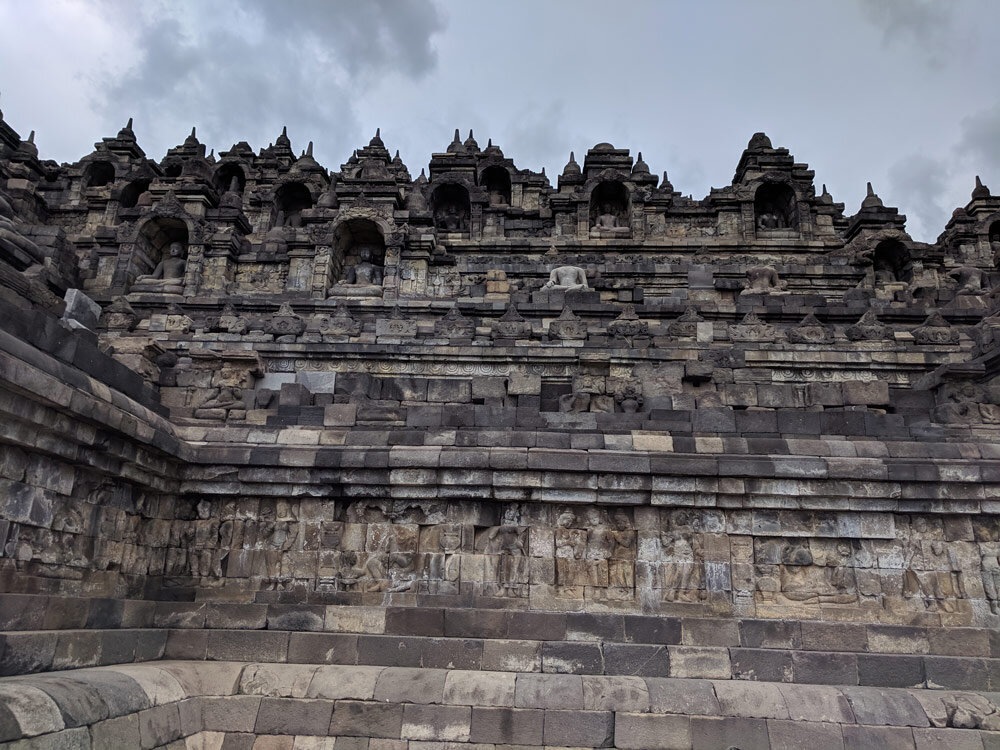Legends and Beauty of the Restored Temple at Borobudur - Indonesia
What is it - The restored beautiful temple of Borobudur is located in the central part of Indonesia’s Java Island in close proximity to several volcanoes including the still active Mt. Merapi which is readily visible only 25 miles to the east. Borobudur is the largest Buddhist monument in the world and represents the pinnacle achievement of the many temples and shrines built by several powerful Hindu and Buddhist kingdoms that dominated the island of Java until around the 12th century.
Legendary History
There are many legends that surround the history of Borobudur. It is generally believed that a ruler of the Saliendra dynasty known as King Samaratungga completed the temple around 800 to 825 AD after 75 years of construction. While that kingdom either relocated to the east over the next hundred years or was incorporated into nearby Hindu kingdoms, Buddhists continued to hold rituals at Borobudur until the 15th century. The temple faced many challenges during this period including a large volcanic eruption in 1006 AD which blanketed central Java and the Borobudur site with ash and the conversion of most of region’s population to Hindu and Islam.
The site gradually fell into disuse and decline, but it continued to serve as a refuge of sorts from time to time. An Indonesian history of the Islamic kingdom of Mataram reported that in 1709, a rebel leader known as Ki Mas Dana fled to the temple and made it his military stronghold in a last ditch effort to overthrow the Sultan before eventually being captured and killed. Other writings from that era report that in 1758 the crown prince of the Sultanate of Yogyakarta ran away from his father to visit the “the mountain of 1000 statues” at Borobudur. He was subsequently dragged back home where he immediately died of disease.
Raffles’ Rediscovery
Colonial traders from Portugal and then The Netherlands who colonized almost all of Indonesia between the 16th and 19th centuries showed little interest in the ruins or legends of Borobudur. That was not the case when Thomas Stafford Raffles, the Lieutenant Governor of Java from 1811 to 1816, presided over the island during a brief period of British administration. Raffles later became famous in 1824 as the official who made the city of Singapore a British possession. In 1814, having heard about many ancient places in Java, Raffles sent a Dutch engineer named H.C. Cornelius to investigate reports of crumbling and overgrown ruins.
With a team of 200 workers, Cornelius managed to clear the site. His efforts revealed the existence of a huge structure which was visited by Raffles on several occasions. Although the top portion of the temple had collapsed, enough information was gathered for Raffles to describe the temple in his 1817 book “The History of Java” as follows: “Boro Bodo is a square stone building consisting of seven ranges of walls, each range decreasing as you ascend, till the building terminates in a kind of dome… This is surrounded by a triple circle of towers in number seventy-two, each occupied by an image looking outwards, and all connected by a stone casing on a hill which externally has the appearance of a roof… The walls which support these terraces are covered with the richest sculpture on both sides.”
Shortly after the rediscovery of Borobudur by Raffles, the British returned control of the East Indies to the Dutch. Thereafter, other than becoming a target for official and unofficial looting of relics, the site languished except for some limited repairs performed in the early 20th century. Finally, the government of Indonesia with the assistance of UNESCO and private donors organized a Save Borobudur campaign in 1968. The plan included the full cleaning and restoration of the site including solving the internal drainage problems which threatened the integrity of the entire building. After completing the restoration in 1983, Borobudur became available for regular tourist visits and it achieved World Heritage site designation in 1991.
Buddhist Universe
Today, Borobudur is the number one tourist attraction in Indonesia attracting 2.5 million visitors each year. People climb ten levels of the terraced monument and walk around its impressive features. These include 1460 carved relief scenes about the life of Buddha or parables about the meaning of daily life and the importance of right behavior. Some carvings show praiseworthy activities such as being charitable and helpful to others, along with the rewards of such actions in this life or the future ones. Other more graphic carvings, which depict blameworthy activities and the severe punishments one may receive, are reportedly buried beneath the earthen foundation which was built to support the restored structure. Watching over the ancient pilgrims and modern tourists viewing these carvings on the lower levels are 432 small stone Buddha’s placed into recessed niches.
Viewed from the air, the temple has been interpreted as a representation of the universe. It was built in the shape of a gigantic mandala-yantra to allow a pilgrim to walk through different levels in a symbolic search for enlightenment. The top three levels of the monument display 72 bell-shaped stupas, 70 of them encapsulating a statue of the Buddha in meditation. At the top in the center of the monument is a huge 30 foot high mother stupa. The top platforms of Borobudur also provides a great viewing platform to look at the surrounding landscape and see rice fields, villages, mountains and volcanoes. Merapi recently erupted in 2010 covering the temple with an inch of ash and killing all of the surrounding vegetation, so nature continues to exert its control over Borobudur’s future.
The incredible symmetry and workmanship of the monument has led most experts to conclude that as many as 30,000 craftsmen worked on Borobudur. The building of Borobudur is even more impressive when you consider that it predated by several hundred years the other treasured ruins of Southeast Asia such as Angkor Wat, the temples of Bagan in Myanmar, and Ayutthaya in Thailand.
Enjoying a Trip to Borobudur
Indonesia is not easy to get to. It takes about 20 hours of flying time whether you head west across the Pacific or east across Europe and the Middle East. Most people going from the United States to Indonesia fly first into Hong Kong on Cathay Pacific, into Singapore on Singapore Airlines, through Dubai on Emirates Air or into Bangkok by connecting flights, and then take a shorter flight into Indonesia. Indonesian airlines fly round trip to many locations in Asia and have improved considerably in recent years but the overall safety record of its carriers may not provide the level of comfort some people want to have when flying to a distant land. Another alternative is that several cruise lines including Viking Ocean, Princess and Azamara have cruises which end in Indonesia or visit ports close enough to make a trip to Borobudur.
One increasingly popular activity at Borobudur is to view the sun rising or setting on the temple from various vantage points. With or without this experience, the site warrants a four hour visit to be fully appreciated. The travel time to Borobudur on local roads is only an hour from the nearby city of Yogyakarta so a day trip from there is convenient. Since it is almost a three hour drive from the other closest major city of Semarang, an overnight stop is recommended if that is your point of origin. Once you arrive at the site, a prearranged guide with a reputable firm will enhance your experience but it is not essential to taking in the wonders of Borobudur.
A visit to Borobudur and the nearby World Heritage site of Hindu ruins at Prambanan, coupled with some time seeing the temples and beaches of Bali make an excellent combination for any experienced traveler interested in seeing both history and relaxation in an exotic location.




